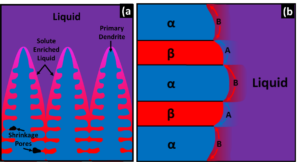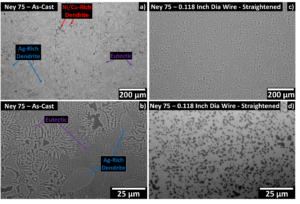Issue 040, July 26, 2022
Wade A. Jensen, Ph.D., Sr. Research Metallurgist
Deringer-Ney Inc. (DNI) alloys are created by mixing molten multiconstituent charges in high temperature induction casters. While molten, the equilibrium state is a homogeneous solution, but this does not necessarily translate to a homogeneous solid solution upon solidification¹. The as-cast microstructure is inherently different from the microstructure of the products made from wire, ribbon, sheet, or foil; the desired properties and processibility would not be achieved without additional engineering.
The as-cast microstructure of a material system can be modeled by its solidification pathway, as followed on the binary phase diagram of a eutectic system in Figure 1. The composition, as well as the solidification rate, greatly influences the morphology and length scale of the as-cast microstructure.

Figure 1: Schematic of a eutectic binary phase diagram annotated with microstructures.
There are two solidification modes that are common among precious metal alloys: 1) dendritic solidification which occurs when the solidifying composition passes through a liquid + solid two-phase region (L → α/β + L) and 2) eutectic solidification that occurs whenever a liquid solidifies into two solid phases (L → α + β). As an off-eutectic composition solidifies, it is possible to produce both dendritic and eutectic solidification (L → α/β + L → α/β + α + β).
Eutectic Solidification – Eutectic solidification progresses through cooperative, and simultaneous, growth of two different crystalline solid phases. In this case, both solutes are rejected from the solidification front: solute B accumulates in front of the α phase and solute A accumulates in front of the β phase. The solute then diffuses along the solid/liquid interface into their designated phase, Figure 2.b). This often results in self-assembled microstructures with periodically repeating lamellae, script, rods, or equiaxed particles³.

Figure 2: Diagrams depicting a) dendritic growth and b) eutectic solidification.
Ney 75 – Ney 75 has three main constituents and presents a complicated as-cast microstructure, but this ternary system still obeys the pattern discussed above. Two dendrites grow from the liquid phase; first a primary Ni-Cu rich dendrite and then a secondary Ag-rich dendrite. Between these dendrites exists an eutectic Ag + Cu phase, Figures 3.a) and 3.b). The as-cast microstructure is not beneficial for commercial properties and a series of cold work and heat treatment practices are designed to optimize hardness and conductivity. As can be seen in Figures 3.c) and 3.d), this processing flow path significantly alters the types and fractions of microconstituents present.
Paliney® 6 and Grain Refining – A common metallurgical practice to improve the processibility, and final properties, is grain refining. Grain refining utilizes particles suspended in the liquid phase that act as additional heterogeneous nucleation sites. This increases the nucleation and constrains grain growth, resulting in a finer grain structure. Many Deringer-Ney alloys in both Paliney® and Neyoro™ families utilize this technique. As shown in Figure 4, an as-cast Paliney 6 alloy that lacks grain refiner consists of large dendrites. In contrast, Paliney 6 that contains a proper, dilute addition of grain refiner significantly reduces the dendrite size and creates more equiaxed grains. This microstructure improves processability due to smaller, equiaxed grains. It should be mentioned that there is a point of diminishing returns; DNI has carefully optimized this melt process by exploiting liquid-to-solid phase transformations to produce high quality material for noble metal applications.

Figure 3: Optical micrographs depicting dendrites and eutectic microstructure in Ney 75 as-cast material at a) 100x and b) 1000x magnification, and the final microstructures of Ney 75 at 0.118 inch diameter wire at c) 100x and d) 1000x magnification.

Figure 4: Optical micrographs of etched Paliney 6 samples depicting a) a dendritic microstructure caused by an absence of grain refiner and b) a small, equiaxed grain structure caused by grain refining.
Paliney® and Neyoro™ are registered trademarks of Deringer-Ney Inc.
References:
- W. Jensen, Tech Brief 030 – Mixing of Metals: Solid Solution vs Immiscible vs Intermetallic, in: Deringer-Ney Tech Brief, 2022. https://www.deringerney.com/resource-library/.
- D.A. Porter, K.E. Easterling, 4.3 Alloy Solidification, in: Phase Transformations in Metals and Alloys, Second Edition, Chapman & Hall, 1997: pp. 207–232.
- D.M. Stefanescu, 9 Eutectic Solidification, in: Science and Engineering of Casting Solidification, 2nd ed., 2009: pp. 195–244.
